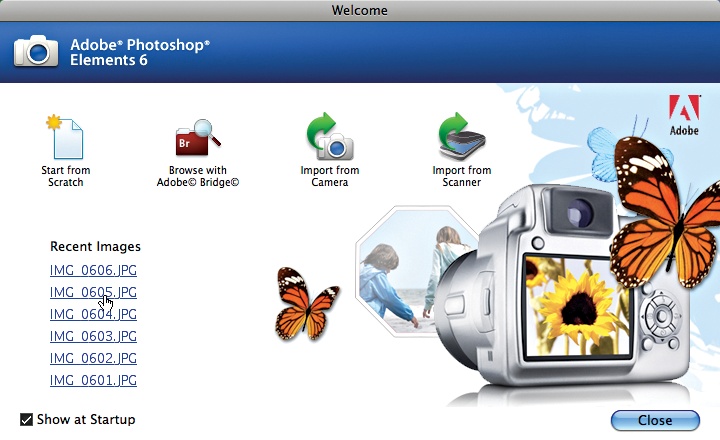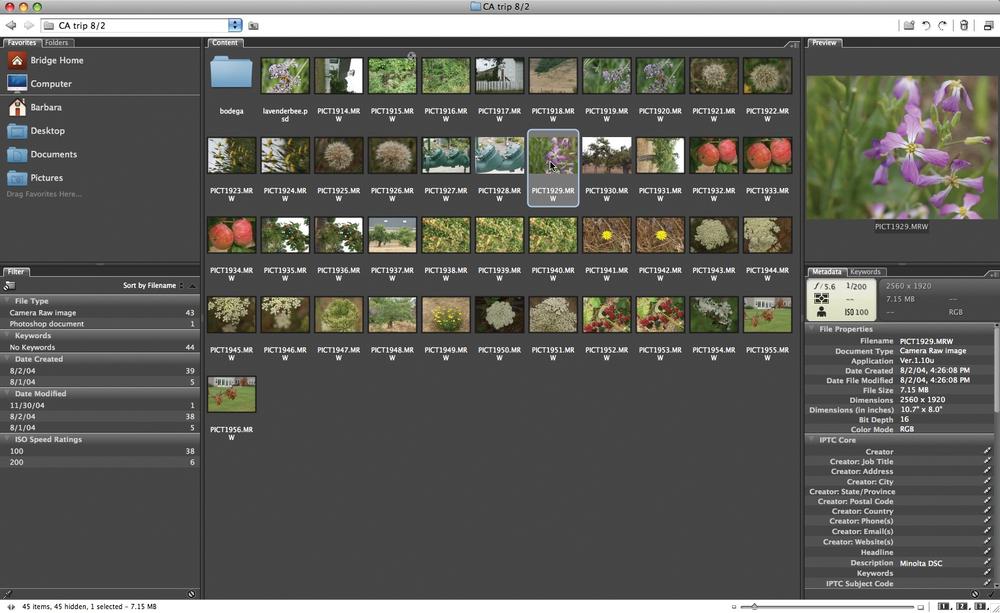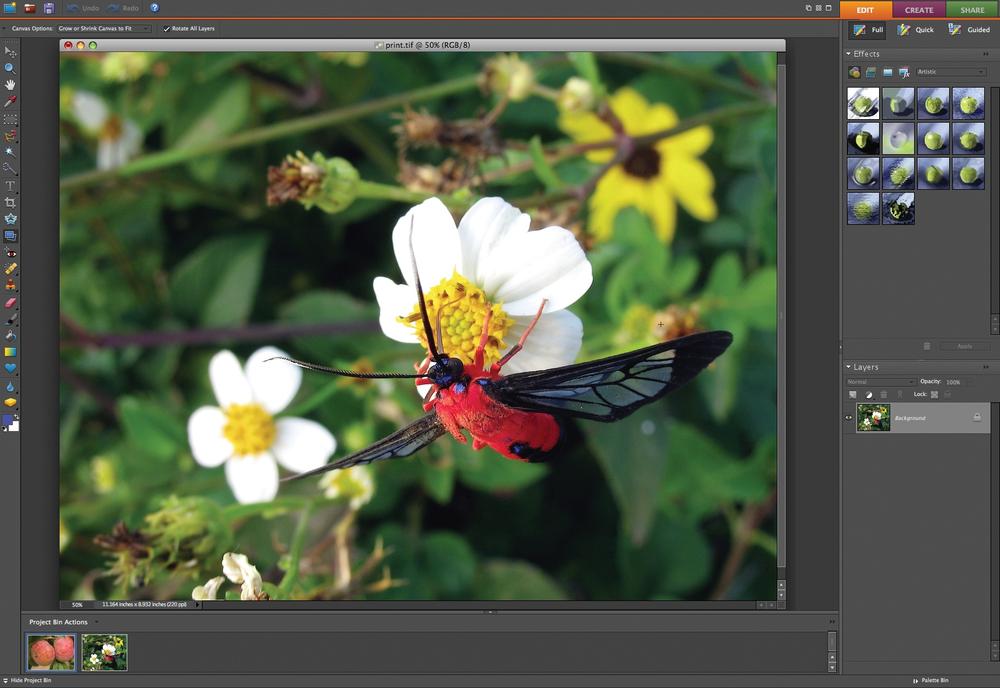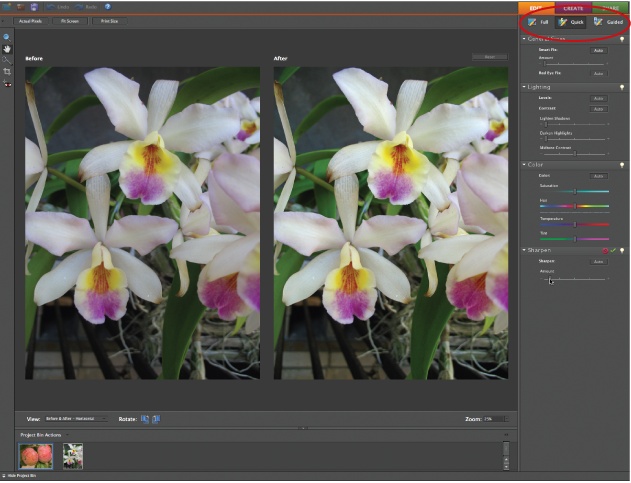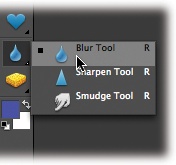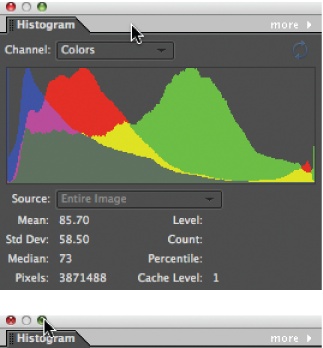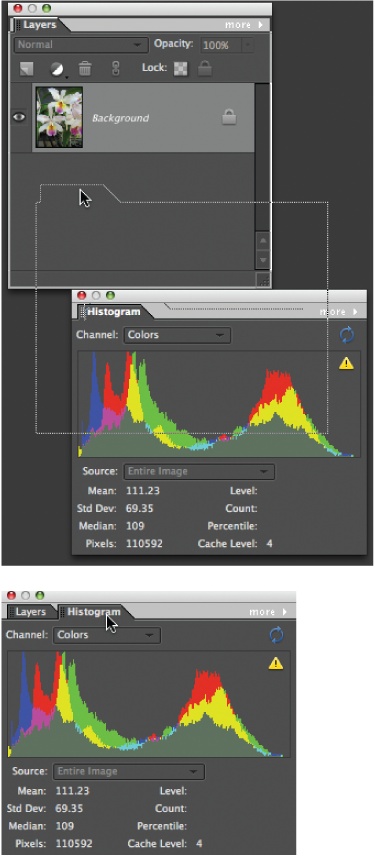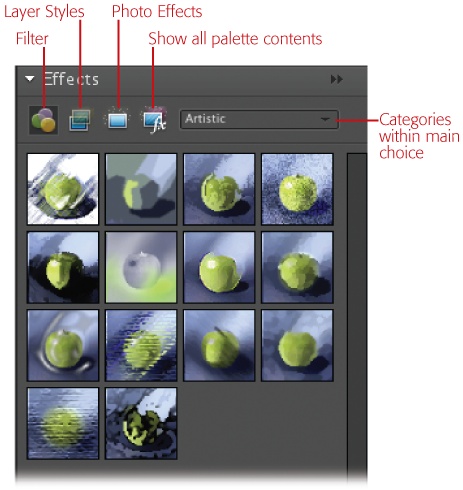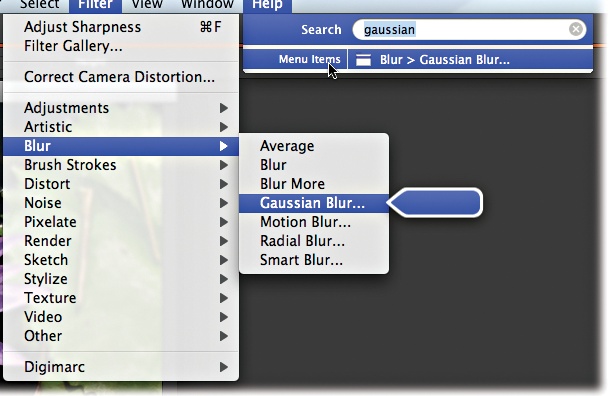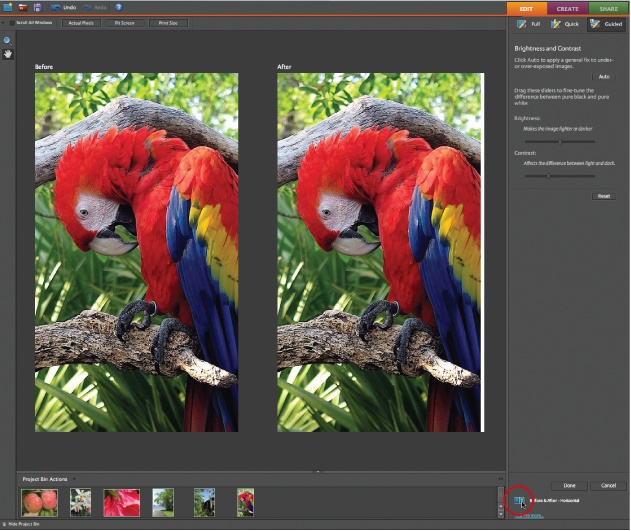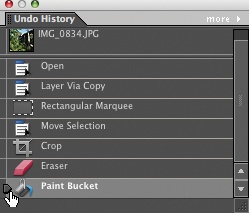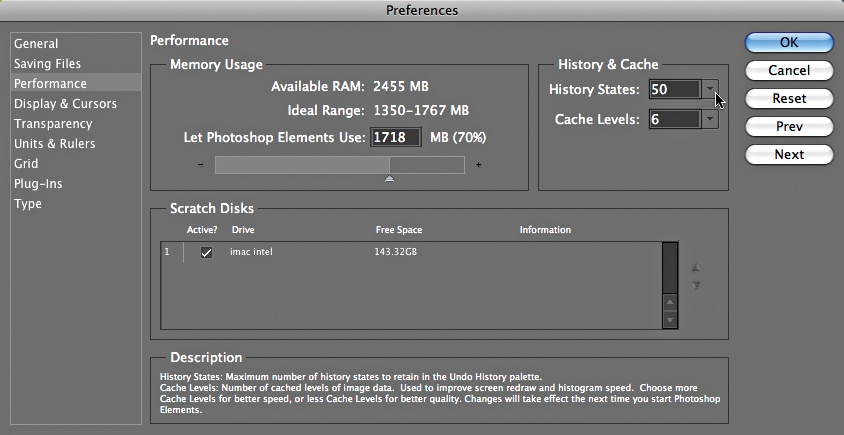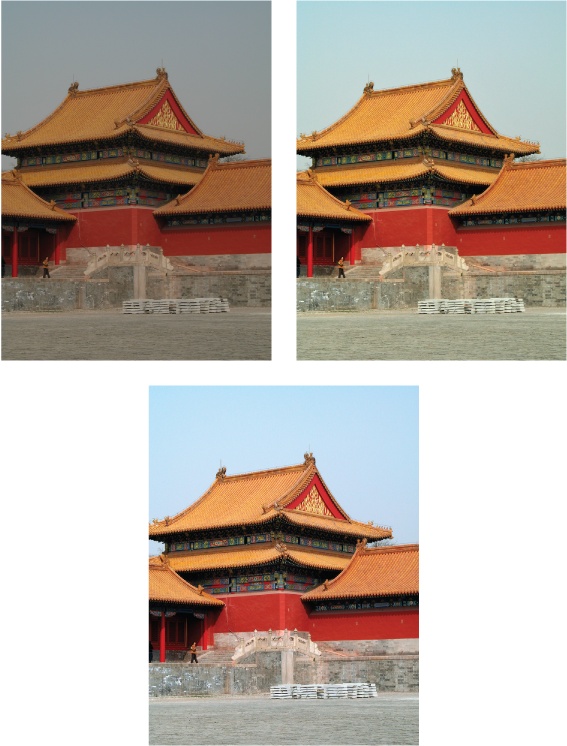Chapter 1. Finding Your Way Around Elements
Photoshop Elements lets you do practically anything you want to your digital images. You can colorize black-and-white photos, remove demonic red-eye stares, or distort the facial features of people who’ve been mean to you. The downside is that all those options can make it tough to find your way around Elements, especially when you’re new to the program.
This chapter helps get you oriented in Elements. You’ll learn about what to expect when you start up the program and how to use Elements to fix your photos with just a couple of keystrokes, as well as how to use the new Guided Edit mode to help you get started editing your photos. Along the way, you’ll find out about some of Elements’ basic controls and how to get hold of the program’s Help files if you need them.
The Welcome Screen
To launch Elements for the first time, you need to go to your Applications folder and open the Adobe Photoshop Elements 6 folder you find there. Double-click the Photoshop Elements icon to start the program (it’s the blue circle icon with the silver camera on it). When you do so, the Elements icon appears in your Dock. (To keep Elements in your Dock when you quit the program, right-click [Control+click] the icon and choose “Keep in Dock”.)
Note
Elements will take a while to start up the first time you launch it, because it’s building a database for the Content and Effects palettes. Don’t be concerned if the program seems to hang—just give it a minute to finish. Once Elements creates the database, it’ll launch much more quickly in the future.
When you first launch Elements, you get a veritable smorgasbord of options, all neatly laid out for you in the Welcome Screen (Figure 1-1). It offers you no less than four options for where to start:
Start from Scratch. This brings up the New File dialog box, where you set your options for a new, blank file. You can read more about your choices in this window on Creating a New File.
Browse with Adobe Bridge.Choose this option and Elements launches Adobe Bridge, a second program you got with Elements that lets you look through your photos and choose one to work on. Bridge does lots of other things, too; there’s more about it on Adobe Bridge—Decisions, Decisions.
Note
If you use iPhoto, you shouldn’t use Bridge to try to see into your iPhoto library. See the next section for more about why not.
Import from Camera. You got yet another extra program with Elements: the Adobe Photo Downloader. If you click this button on the Welcome Screen, Elements sends you over to Bridge and launches the Photo Downloader. However, you may not want to do this, especially if you use another program like iPhoto to organize your photos, or if you use another download program like Canon’s ImageBrowser. There’s more about the Downloader on The Photo Downloader.
Import from Scanner. If your scanner driver allows you to scan directly into Elements, click this button and, in the window that appears, select your scanner from the pull-down menu. Of course, you need to have your scanner driver and any necessary Photoshop plug-ins (Scanning Photos) for your scanner installed or this won’t get you anywhere. (Many scanners come with software that lets you scan and save your scan. You can then open the resulting file in Elements like any other image, as long as you saved it in a format that Elements can read—see Saving Your Work.) If you have a Mac with an Intel processor and your scanner plug-in is old, when you launch Elements, you may see a message about plug-ins not loading. See Capturing Video Frames for what to do about that.
Note
If Elements doesn’t recognize your scanner but you know you should be able to scan into Elements, try reinstalling your scanner driver and any scanner plug-ins.
If this isn’t the first time you’ve launched Elements, you’ll also see a list of recently opened files in the lower-left part of the window. Click a photo’s name to open it.
You don’t have to choose any of these options if you don’t want to. Just click the Close button in the lower right and you’ll find yourself in Elements, free to do whatever you want. You can even turn off the Welcome screen altogether if you want to, as explained in the box below.
Adobe Bridge—Decisions, Decisions
When you first start using Elements 6, you have a decision to make: How do you want to organize and search for your photos?
Of course, you can decide not to organize your photos, but it sure can make them hard to find. These days, everyone has lots of photos to deal with, whether you take them with your camera or cellphone or you’re busy scanning in old prints. Most people want to organize photos so they can easily find particular photos when they need ‘em.
With that in mind, Adobe gives you Bridge CS3, the image browser that comes with full Photoshop and the other Creative Suite programs. (You can see Bridge in Figure 1-2.) In some ways, this is a big step up from the File Browser in early editions of Elements or the Organizer that comes with the Windows version, especially if you shoot RAW. (Chapter 8 has info about RAW formats.) You can use Bridge to search for, move, and assign keywords and ratings to your photos, and to get tons of detailed information about them.
But if you’re like a lot of Mac folks, you already use some kind of photo organizer. iPhoto, which comes with all new Macs, is by far the most popular, but Apple’s Aperture and Adobe’s Lightroom also have big followings. If you use one of these programs, you probably don’t want to use Bridge most of the time. For one thing, trying to get into your photo database (like the iPhoto library file, for example) from Bridge or any application other than the program that created it can make bad things happen. The iPhoto library file, in particular, is prone to corruption if you mess with it from outside iPhoto, and that can cause big problems.
The good news is that you can send your photos directly to Elements from within any of these organizer programs (Sending Images from Other Programs has the details). So for most tasks, it’s best to avoid Bridge entirely.
However, if you want to make any of the online projects that are built into Elements (see CD/DVD Label), you’ll get bounced over to Bridge during the process, so you’ll need to deal with Bridge a little bit, even if it’s not your main way of organizing photos. Working with PDF Files gives you a rundown of the Bridge basics you need to know.
If you’re not already locked into another photo organizer, Bridge lets you do a lot of useful things with your photos, like rate them, move and rearrange them, and assign metadata keywords to them that lots of programs can understand. For many people, Bridge can be a valuable tool, especially if you prefer your own folder structure. You may find that Bridge is all you need for organizing your photos. There’s lots more about it on Opening Photos in Elements.
The Photo Downloader
Along with Bridge, you get the Adobe Photo Downloader. You can use the Downloader to get photos from your camera, but in OS X, you already have Image Capture that handles that part for you, and does a fine job. For most people, the Downloader isn’t terribly useful, and Adobe makes it easy to forget it even exists, since you can only launch it from Bridge or Elements. (It’s not a standalone program like the Downloader that comes with the Windows version of Elements, although you can set it launch automatically any time you connect a camera or card reader, even if Bridge and Elements aren’t running.)
Note
Although both the Mac and Windows versions of Elements include a Photo Downloader, there are a number of differences between the two. The Mac version doesn?t let you choose among different types of media to view and import, or let you correct red eye or create automatic stacks as you download your photos.
Few Mac people use the Downloader at all, but it can be useful in a few situations:
Convert to DNG. If you shoot RAW files (The RAW Converter) and you want to convert them to DNG files as you import them, the Downloader can do this automatically. (Converting to DNG has info about the DNG format.) You can convert to DNG in a couple of other ways in Elements, though, as Chapter 8 explains.
Add Metadata. This is the most important feature of the Downloader. As you import your photos, you can tell the Downloader to add an author or copyright holder to the photo’s information. Or you can create your own custom metadata template (a list of info about the picture that gets stored as part of the file, like who took it or a keyword to help you find the photo by searching) and apply it to every photo you import. (There’s lots more about metadata on Keywords.) You can also use Bridge to add or edit metadata (even for batches of pictures), if you prefer—see Keywords.
You can launch the Downloader at any time if you want to check it out. In Elements, go to File → Adobe Photo Downloader; in Bridge it’s File → Get Photos from Camera. (Since most people with Macs aren’t too interested in the Downloader, it’s not covered in depth in this book. If you want to know more about how to use it, you’ll find detailed Downloader instructions on this book’s Missing CD page at www.missingmanuals.com.)
Getting Started in a Hurry talks more about getting photos into Elements, including some of the nifty new ways of browsing through your pictures in Leopard (OS X 10.5) right in the Finder.
Editing Your Photos
The main component of Elements is the Editor (Figure 1-3), where you get to edit, adjust, transform, and generally glamorize your photos, and where you can create original artwork from scratch with the drawing tools and shapes.
You can operate the Editor in any of three different modes:
Quick Fix. For many beginners, Quick Fix (Figure 1-4) ends up as your main workspace. Adobe has gathered together the basic tools you need to improve most photos. It’s also one of the two places in Elements where you can choose to have a before-and-after view while you work. (Guided Edit, described below, is the other.) Chapter 4 gives you all the details on using Quick Fix.
Full Edit. The Full Edit window gives you access to Elements’ most sophisticated tools. You have far more ways to work on your photo in Full Edit than in Quick Fix, and if you’re fussy, it’s where you’ll do most of your retouching work. Most of the Quick Fix commands are also available via menus in the Full Edit window.
Guided Edit. This is new in Elements 6, and it can be enormously helpful if you’re a newcomer to Elements. Basically, it provides a step-by-step walk-through for popular projects such as cropping your photos and removing blemishes from them. Like Quick Fix, Guided Edit offers a before-and-after view of your photo as you work on it. Guided Edit is explained on Guided Edit.
There are also tabs for making projects (Create) and sharing files (Share). You’ll learn about working in these tabs in Chapters Chapter 15 through Chapter 17.
The rest of this chapter covers some of the basic concepts and key tools you’ll come across in Elements.
Your Elements Tools
Elements gives you an amazing array of tools to use when working on your photo. You get almost two dozen primary tools to help you select, paint on, and otherwise manipulate your photos, and many of the tools have as many as six subtools hiding beneath them (see Figure 1-5). Bob Vila’s workshop probably isn’t any better stocked than Elements’ virtual toolbox.
Tip
When you want to explore every cranny of Elements, you need to open a photo (choose File → Open). Lots of the menus are grayed out if you don’t have a file open.
The long, skinny strip on the left side of the Full Edit window is the main Elements Toolbox, as you can see in Figure 1-5. It stays perfectly organized so that you can always find what you want without ever having to lift a finger to tidy it. And what’s more, if you forget what a particular tool does, then hold your mouse over the tool’s icon and a label (called a tooltip) appears. To activate a tool, click it. Any tool that you select comes with its own collection of options, as shown in Figure 1-6.
Incidentally, in Elements 6 your screen size determines the number of rows in the Toolbox. If you have a small screen, you have a double-column Toolbox. If your screen is large enough to show all the tools in one long column, that’s how your Toolbox appears. (Nearly all recent Mac monitors show the single column.) If you’d rather have a more compact Toolbox, see the box “Doubling Up.”
Other windows in Elements, like Quick Fix and the RAW Converter (see The RAW Converter), also have toolboxes, but none is as complete as the one in Full Edit.
Note
If you’ve used Elements before, you’ll find an important difference in getting to subtools in Elements 6. The only way to choose a tool from a group in Elements 6 is by using the tool’s pop-out menu in the Toolbox. You can’t switch from one tool in a subgroup to another in the Options bar anymore.
Don’t worry about learning the names of every tool right now. It’s easier to remember what a tool is once you’ve used it. And don’t be concerned about how many tools you have available. You probably have a bunch of Allen wrenches in your garage toolbox that you don’t use more than a couple of times a year. Likewise, you’ll find that you tend to use certain Elements tools more than others.
Tip
You can activate any tool with a keyboard shortcut, thereby saving a ton of time, since you don’t have to interrupt what you’re doing to trek over to the Toolbox. To see a tool’s shortcut key, hover your mouse over the icon. A tooltip (Getting Help) pops up that tells you the shortcut key (it’s the letter in parentheses).
Panels, Bins, and Palettes
No matter which editing mode you’re in, the right side of your screen is always pretty busy. Adobe calls this area the Task panel. You use it to select different modes, like whether to edit a photo or use it in a project.
Once you click a tab, you see your choices for that tab: the different editing modes under the Edit tab, for instance, or a list of projects you can make with the Create tab. You can collapse the main part of the Task panel to get it out of your way by clicking its left edge, but the main tabs are always visible. Click the edge again to bring the panel back.
The Project bin
The long narrow photo tray hogging the bottom of your screen is called the Project bin (Figure 1-7). It shows you what photos you currently have open, and offers you a shortcut to the Create and Share modes.
You can drag your photos’ thumbnails in the bin to rearrange them if you want to use the photos in a project. Using the Project bin’s pull-down menu, you can:
Create. Use your photos in one of Elements’ built-in projects in the Create Tab, like a Photo Collage or DVD label. See Chapter 15 for more about creating projects.
Share. This menu option takes you to the Share tab, where you can email your photos or create a Web gallery for them. There’s more about the Share tab in Chapter 17.
Print Project Bin Files. You can start a picture package (Picture Packages) right from this menu, if you like.
All these options are also available in other places, so you don’t need to keep the bin around just for them.
The Project bin is a useful feature, but if you have a small monitor, sometimes you may prefer to have the space for your editing work. If you don’t want to see the bin all the time, you can collapse and expand it. To close the bin, click the Hide Project Bin arrow at the lower left of your screen. Click the arrow again when you want the Project bin to reappear.
Note
If it bothers you to have multiple photos open in the Full Edit workspace, click the yellow minimize buttons on the photos you want to move out of your way. They’ll glide offscreen into your Dock. You can bring them back into the Elements workspace by double-clicking them in the Project bin, or clicking them in the Dock.
The Palette bin
When you’re in Full Edit, the Task panel displays the Palette bin. Elements stores palettes in this bin, letting you do things like keep track of what you’ve done to your photo (Undo History palette) and apply special effects to your images (Effects palette and Content palette).
With most recent Mac monitors, the Palette bin is no problem—your Mac’s widescreen monitor gives you plenty of space for it. If you don’t have a large monitor, you may find it wastes too much desktop acreage, and in Elements, you need all the working room you can get. Fortunately, you don’t have to keep your palettes in the bin; you can close the bin and just keep your palettes floating around on your desktop, or you can minimize them.
You open and close the bin by clicking the Palette bin button at the bottom of your screen (below the bin), or you can click the Palette bin’s left edge (anywhere along the thin vertical bar). You can also pull palettes out of the bin by dragging the name bar of any palette. Figure 1-8 shows how to make your palettes even smaller once they’re out of the bin. Freestanding palettes can also be combined with each other, as shown in Figure 1-9.
Only two palettes are in the Palette bin to start with: Layers and Effects. To see how many more palettes Elements actually gives you, check out the Editor’s main Window menu (the one at the top of your screen). When you select a new palette, it appears floating on the desktop. If you want to put a palette into the bin, click the little double arrow at the upper right of the palette and choose “Place in Palette Bin when Closed”, and then click the Close button. The palette jumps into the bin. To take a palette out of the bin, drag it out, and then go back to the menu and deselect “Place in Palette Bi when Closed.” The next time you close the palette, it disappears and you have to choose it from the Window menu to see it again.
Note
If you’ve been going crazy because you’re trying to get rid of one of the bin’s original palettes (either the Layers or Effects palette), but every time you close it, it just hops back into the bin, click the More button in the upper-right corner of the palette and turn off “Place in Palette bin when Closed.” Next time you close the palette, it goes away and won’t return till you choose it again from the Window menu.
Special palettes
As Adobe adds more and more goodies to Elements, organizing everything so that you can get to it quickly has become something of a problem. To help reduce the clutter in Elements 6, Adobe has come up with a couple of new palettes, and new ways to navigate some old friends.
When you first launch Elements, you see the Effects palette as one of the palettes in the bin. The Effects palette lets you add special effects to your images. It gives you access to filters (Using Filters), Layer styles (Adding Layer Styles), and Photo Effects (Adding Effects). To use it, click the icon for the main type of effect you want, as explained in Figure 1-10, and then use the pull-down menu to choose a category. You apply the effect by double-clicking its thumbnail or clicking the thumbnail once, and then clicking Apply, or just by dragging the thumbnail onto your photo.
Note
Both the Effects and Content palettes have a little trash can at the bottom of the window. Be careful: Clicking it deletes the selected palette item permanently until you reinstall Elements. It’s for getting rid of palette content you’re sure you don’t want (the Layer style, say, or the Background graphic), not for removing something from your current image. Don’t use it to remove an effect or piece of artwork—use one of the escape routes described on Escape Routes instead.
The other special palettes are the Content palette and the Favorites palette. They’re actually loaded when you first start Elements, but you don’t see them because they’re hidden away in the Create tab. To see them, click Create. Just below the main Create tab, you’ll see two sub-tabs. When you enter Create for the first time, Projects is the active tab. If you click the Artwork sub-tab, the Task panel switches over to show you the Content and Favorites palettes.
The Content palette holds backgrounds, frames, graphics, shapes, text effects, and themes to use in your projects. The Favorites palette provides a convenient parking space for everything from the Effects and Content palettes that you use all the time and want to keep handy. You can read more about how to use these palettes on Working with the Content and Favorites Palettes.
The Content and Favorites palettes tend to resist if you try to haul them out of the bin when you’re in the Create tab’s Artwork mode. If you want one (or both) of them on your desktop in Full Edit, it’s easiest to start by going to the Window menu and choosing the palette there. Then you can dock it in the Palette bin if you like, or keep it free floating by using the methods described above. (They still appear in Artwork even when you set them to show in Full Edit, too.)
Note
Elements has one palette-related quirk. In the Window menu, visible palettes should have a checkmark next to their names. (Palettes that are open in another tab but not currently visible have a dash next to their names.) But if you collapse a palette, even though the palette’s name stays on your desktop, it remains unchecked in the Window menu. If you lose a collapsed palette (they occasionally get hidden behind the Options bar when you switch back and forth from Full Edit to Quick Fix), just select the palette’s name in the list again to bring it back to the front where you can reach it. If all else fails, choosing Reset Palette Locations in the Window menu puts everything back in its original position.
Getting Help
Wherever Adobe found a stray corner in Elements, they stuck some help into it. You can’t move anywhere in this program without being offered some kind of guidance. Here are some of the ways you can summon assistance if you need it:
Help menu. Choose Help → Photoshop Elements Help. Elements launches the Adobe Help Viewer and you’ll see the Elements Help files displayed there. (There are separate Help files for Bridge and for Elements, so you may need to choose the correct program from the pull-down menu in the upper left of the Help Viewer window.) In the Help Viewer, you can search or browse a topic list and glossary. If you’re using Mac OS X Leopard, you’ll also see a Search box where you can type in a search term. This doesn’t search the Elements Help files, but rather lets you search the Elements menus, a very cool feature, as explained in Figure 1-11.
Tooltips. The text that pops up under your mouse as you move around Elements is linked to the appropriate section in Elements Help. Click a tooltip for more information about whatever your mouse is hovering over.
Dialog box links. Most dialog boxes have a few words of bright blue text somewhere in them. That text is actually a link to Elements Help. If you get confused about what the settings for a filter do, for instance, then click the blue text in the settings dialog box for a reminder.
Guided Edit
If you’re a beginner, your biggest help in Elements may be the new Guided Edit feature, shown in Figure 1-12. Guided Edit walks you through a variety of the editing tasks you’re likely to want to do, like cropping, sharpening, correcting colors, and removing blemishes.
Guided edit is really easy to use:
Go to Guided Edit.
Click the Edit tab → Guided.
Figure 1-12. Guided Edit gives you step-by-step help with basic photo editing. Just use the tools that appear in the task panel once you choose an activity. After you’ve selected a task, you can change the view of your photo to Before and After. Keep clicking the little blue button (circled) at the bottom of the window to toggle views between After Only, Before & After—Horizontal, and Before & After—Vertical.Press ⌘ +O and choose your photo in the window that appears. If you already have a photo open, it appears in the Guided Edit window automatically. If you have several photos in the Project bin, you can switch images by double-clicking the thumbnail of the one you want to work on.
Choose what you want to do.
Your options are grouped into major categories like Basic Photo Edits and Color Correction, with a variety of individual projects under each heading. Just click the specific task you want in the list on the right side of the window. The Task panel switches to show you the buttons and/or sliders you need to use.
Make your adjustments.
Just move the sliders and click the buttons till you like what you see. If you want to start over, click Reset. If you change your mind about the whole project, click Cancel.
If there are several steps (like there are in “Guide for Editing a Photo”, for instance), Elements will show you just what you need to use for the current step, then switch to a new set of choices for the next step as you go along.
Click Done to finish.
If there are more steps, you may see another set of instructions. If you see the main list of topics again, you’re all through. Don’t forget to save your changes (Importing from Cameras). To close your photo, press ⌘ +W, or leave it open and switch to another tab to share it or use it in a project.
If you need to adjust your view of your photo while you work on it, Guided Edit has a little toolbox with the Hand (The Hand Tool) and Zoom (The Zoom Tool) tools to help you out.
Note
Guided Edit shows you quick and easy ways to change your image, but you won’t always get the best possible results. It’s a great tool for starting out, but don’t make the mistake of thinking what you see here is the best you can possibly do for your images. Once you’re more comfortable in Elements, Quick Fix (Chapter 4) is a good next step.
Escape Routes
Photoshop Elements has a couple of really wonderful features to help you avoid making permanent mistakes: the Undo command and the Undo History palette. After you’ve gotten used to them, you’ll probably wish it were possible to use these tools in all aspects of your life, not just Elements.
Undo
No matter where you are in Elements, you can almost always change your mind about what you just did. Press ⌘ +Z and the last change you made goes away. Pressing ⌘ +Z works even if you’ve just saved your photo, but only while it’s still open. (If you close your picture, your changes are permanent.) Keep pressing ⌘ +Z and you keep undoing your work, step by step.
If you want to redo what you just undid, just press ⌘ +Y. These keystroke commands are great for toggling changes on and off while you decide whether you really want to keep them.
Tip
You do have some control over the key combination you use for Undo/Redo, if you don’t like the ⌘ +Z combination. Go to Photoshop Elements → Preferences → General. Elements gives you two other choices, both of which involve pressing the Z key in combination with the ⌘ , Option, and Shift keys. You can’t just assign any key combination you like because you’re used to it in another program.
Undo History palette
In the Full Edit window, you get even more control over the actions you can undo, thanks to the Undo History palette (Figure 1-13), which you open by choosing Window → Undo History.
This palette holds a list of the changes you’ve made since the last time you opened your image. Just push the slider up and watch your changes disappear one by one as you go. Undo History even works if you’ve saved your file: As long as you haven’t closed your file, the palette tracks every action you take. You can also slide the other way to redo changes that you’ve undone.
Be careful, though. You can back up only as many steps as you’ve set Elements to remember. Elements lets you keep track of as many as 1,000 actions. You can regulate this number in Preferences, as explained in Figure 1-14.
The one rule of Elements
As you’re probably beginning to see, Elements lets you work in lots of different ways. What’s more, most people who use Elements approach projects in different ways. What works for your neighbor with her pictures may be quite different from how you would choose to work on the very same shots.
However, you’ll hear one suggestion from almost every Elements veteran, and it’s an important one: Never ever work on your original. Always, always, always make a copy of your image and work on that. (If you use a program like iPhoto, it can make a version set for you. In other words, you can tell it to remember one edited version plus your original. See Sending Images from Other Programs for more about version sets.)
Tip
You can easily make a copy of a file in the Finder before you even launch Elements. Click the file once to select it, and then press ⌘ +D, or Option+drag it away from the original and then let go of the mouse button. Either way, the new file automatically gets a name that lets you know it’s not the original, one ending in “copy” or “2,” for example.
Follow these steps to make a copy of your image in Elements:
Go to File → Duplicate.
You can also right-click (Control-click) the photo’s Project bin thumbnail and choose Duplicate there.
Name the duplicate, and click the red close button on the original.
Now the original is safely tucked out of harm’s way.
Save the duplicate using ⌘ +S.
Choose Photoshop (.psd) as the file format when you save it. (You may want to choose another format after you’ve read Chapter 3 and understand more about your different format options.)
Now you don’t have to worry about making a mistake or changing your mind, because you can always start over if you want to.
Note
Elements doesn’t have an autosave feature, so you should get into the habit of saving frequently as you work. Read more about saving on Saving Your Work.
Getting Started in a Hurry
If you’re the impatient type, and you’re starting to squirm because you want to be up and doing something to your photos, here’s the quickest way to get started in Elements: Adjust the brightness and color balance all in one step.
Open a photo.
Press ⌘ +O and navigate to the image you want, and then click Open.
Press Option+⌘ +M.
You’ve just applied Elements’ Auto Smart Fix tool (Figure 1-15).
Voilà! You should see quite a difference in your photo, unless the exposure, lighting, and contrast were almost perfect before. The Auto Smart Fix tool is one of the many easy-to-use features in Elements. (Of course, if you don’t like what just happened to your photo, no problem—simply press ⌘ +Z to undo it.)
If you’re the really impatient type, you can jump right to Chapter 4 to learn about using the Quick Fix commands. But it’s worth taking the time to read the next two chapters so you understand which file formats to choose and how to make some basic adjustments to your images, like rotating and cropping them.
Don’t forget to give Guided Edit a try if you see what you want to do in the list of topics. Guided Edit can be a big help when you’re first learning your way around.
Get Photoshop Elements 6 for Mac: The Missing Manual now with the O’Reilly learning platform.
O’Reilly members experience books, live events, courses curated by job role, and more from O’Reilly and nearly 200 top publishers.
